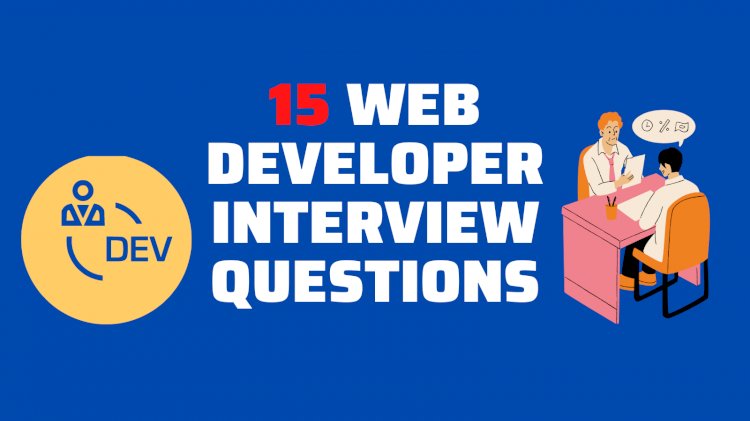TOP 15 Web Developer Interview Questions with answers
Web development is a rapidly growing field and the demand for skilled web developers is on the rise. This article provides a comprehensive overview of common web developer interview questions, covering topics such as key responsibilities, important technologies, web application design considerations, and JavaScript concepts. Whether you're an experienced web developer or a beginner, this article will help you prepare for your next interview.

Web development is a rapidly growing field, and the demand for skilled web developers is on the rise. As a result, it's becoming increasingly important for aspiring web developers to prepare for job interviews by familiarizing themselves with common interview questions. In this article, we'll take a closer look at some of the most frequently asked questions in web developer interviews. From understanding key responsibilities and important technologies, to discussing web application design considerations and JavaScript concepts, this article will provide a comprehensive overview of the topics that are likely to be covered in a web developer interview. Whether you're an experienced web developer looking for a new job, or a beginner looking to break into the field, this article will provide valuable insights to help you prepare for your next interview.
Questions :
-
What are the key responsibilities of Web Developers?
-
List the advantages of HTTP/2 over HTTP 1.1.
-
Explain CORS (Cross-Origin Resource Sharing) and Write its Importance.
-
What do you mean by ETag (Entity Tag) and how does it work?
-
Explain Webpack.
-
List out newly introduced input types, APIs, form elements, and elements that support media content in HTML5.
-
State the difference between span tag and div tag in HTMLS.
-
Explain HTML5 Web storage.
-
Explain DOM (Document Object Model)?
-
What do you know about pair programming?
-
While building a web application, how do you consider SEO, maintainability, UX, performance, and security?
-
State difference between SVG (Scalable Vector Graphics) and Canvas.
-
What is Type Coercion in JavaScript?
-
What is the difference between window.onload and onDocumentReady ?
-
Describe the different kinds of HTTP requests supported by RESTful Web services.
Answers :
- The key responsibilities of a Web Developer include designing, developing, and maintaining websites and web applications. This involves using technologies such as HTML, CSS, JavaScript, and other web development frameworks to build high-quality, user-friendly websites that meet the needs of clients and end-users. They must also ensure that websites are optimized for search engines, are accessible to users with disabilities, and are able to load quickly and smoothly on a variety of devices.
- The advantages of HTTP/2 over HTTP 1.1 include improved speed and efficiency, multiplexing of requests, header compression, server push, and a more efficient binary format. HTTP/2 enables faster page load times and better user experience by allowing multiple requests to be handled concurrently and reducing the amount of data transmitted over the network.
- Cross-Origin Resource Sharing (CORS) is a mechanism that allows a web page to request resources from a different domain to its own. CORS is important because it provides a way for web developers to allow or block specific types of cross-domain requests, improving the security of their web applications and reducing the risk of cross-site scripting attacks.
- ETag (Entity Tag) is a HTTP header used for web cache validation. It is a string of characters that represents a specific version of a resource, such as an HTML page or an image. When a client requests a resource, the server sends the ETag along with the response. If the client already has a cached copy of the resource, it can send the ETag back to the server to see if the resource has been updated. If it has, the server sends the updated resource, otherwise it sends a 304 Not Modified response, indicating that the cached resource is still up-to-date.
- Webpack is a popular JavaScript module bundler that helps developers build, manage, and optimize their web applications. It takes all of the different assets used in a web application, such as HTML, CSS, JavaScript, and images, and combines them into a single file or set of files that can be efficiently loaded by the browser. This helps to improve the performance and load times of web applications.
- Some of the newly introduced input types, APIs, form elements, and elements that support media content in HTML5 include: input types such as email, date, and number; APIs such as Geolocation, Web Storage, and Web Workers; form elements such as placeholder text and required fields; and elements that support media content such as audio and video.
- The span tag and div tag in HTML are both used to define a section of a web page, but they have different purposes. The div tag is used to create a block-level element, which defines a section of the page that can contain other elements, such as headings, paragraphs, and images. The span tag is used to create an inline-level element, which is used to define a small portion of text within a block-level element, such as a single word or phrase.
- HTML5 Web storage is a feature that enables web developers to store data on the client-side, rather than on the server. This allows for faster and more efficient data access, as well as the ability to store larger amounts of data than would be possible with cookies. There are two types of HTML5 Web storage: local storage and session storage, with local storage being the more persistent of the two.
- The Document Object Model (DOM) is a programming interface for HTML and XML documents. It represents a document as a tree-like structure, where each node in the tree represents an element or a piece of text in the document. The DOM provides a way for developers to programmatically access and manipulate the content, structure, and styles of a web page, making it possible to create dynamic and interactive web applications.
- Pair programming is a software development technique in which two developers work together at the same computer, sharing the keyboard and mouse and working on the same codebase. The goal of pair programming is to improve code quality, speed up development, and increase collaboration and knowledge sharing among team members.
- When building a web application, it's important to consider a number of factors to ensure its success. For SEO, it's important to choose relevant and keywords and to structure the web pages and content in a way that is optimized for search engines. Maintainability involves designing and coding the web application in a way that makes it easy to update and maintain over time. UX (user experience) involves creating a web application that is easy to use, intuitive, and enjoyable for users. Performance is crucial for a good user experience, so it's important to optimize the web application for fast load times and smooth functionality. Finally, security is essential to protect sensitive information and to ensure that the web application is protected from attacks.
- SVG (Scalable Vector Graphics) and Canvas are two different technologies used for creating graphics and visual content on the web. SVG is an XML-based format that defines vector graphics, while Canvas is a bitmap-based technology that provides a way to dynamically render graphics and animations in a web page. The main difference between the two is that SVG graphics are resolution-independent and can be scaled up or down without losing quality, while Canvas graphics are resolution-dependent and become blurry when scaled.
- Type coercion in JavaScript is the process of converting one data type into another, such as converting a string into a number. This is a fundamental part of the JavaScript language and can sometimes lead to unexpected results if the programmer is not aware of the type coercion rules.
- The difference between window.onload and onDocumentReady is that window.onload is a traditional JavaScript event that fires when all of the resources on a web page have finished loading, including images, stylesheets, and scripts. On the other hand, onDocumentReady is a custom event that fires when the DOM (Document Object Model) is ready to be interacted with, but before all of the resources have finished loading. This event is commonly used in modern web development to ensure that scripts are executed as soon as the DOM is ready, without having to wait for all of the other resources to finish loading.
- RESTful Web services support several different types of HTTP requests, including GET, POST, PUT, DELETE, and PATCH. GET requests are used to retrieve information from the server, POST requests are used to submit data to the server, PUT requests are used to update data on the server, DELETE requests are used to delete data from the server, and PATCH requests are used to make partial updates to data on the server. Each of these request types has a specific purpose and is used in different ways to interact with RESTful Web service
What's Your Reaction?
















